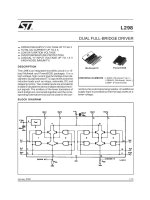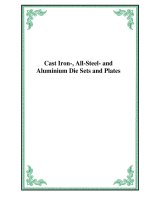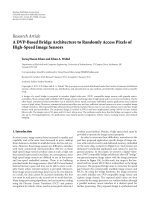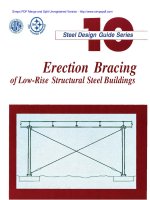Steel Bridge Construction-2 doc
Bạn đang xem bản rút gọn của tài liệu. Xem và tải ngay bản đầy đủ của tài liệu tại đây (2.98 MB, 12 trang )
Durkee, J. “Steel Bridge Construction”
Bridge Engineering Handbook.
Ed. Wai-Fah Chen and Lian Duan
Boca Raton: CRC Press, 2000
© 2000 by CRC Press LLC
45.28 Further Illustrations of Bridges Under Construction,
Showing Erection Methods
Figure 45.14 Royal Albert Bridge across River Tamar, Saltash, England, 1857. The two 455 ft (139 m) main spans,
each weighing 1060 tons, were constructed on shore, floated out on pairs of barges, and hoisted about 100 ft (30
m) to their final position using hydraulic jacks. Pier masonry was built up after each 3 ft (1 m) lift.
© 2000 by CRC Press LLC
Figure 45.15 Eads Bridge across the Mississippi River, St. Louis, Mo., 1873. The first important metal arch bridge
in the U.S., supported by four planes of hingeless trussed arches having chrome-steel tubular chords. Spans are 502-
520-502 ft (153-158-153 m). During erection, arch trusses were tied back by cables passing over temporary towers
built on the piers. Arch ribs were packed in ice to effect closure.
© 2000 by CRC Press LLC
Figure 45.16 Glasgow (Missouri) railway truss bridge, 1879. Erection on full supporting falsework was common-
place in the 19th century. The world’s first all-steel bridge, with five 315 ft (96 m) through-truss simple spans, crossing
the Missouri River.
© 2000 by CRC Press LLC
Figure 45.17 Niagara River railway cantilever truss bridge, near Niagara Falls, New York, 1883. Massive wood
erection traveler constructed side span on falsework, then cantilevered half of main span to midspan. Erection of
other half of bridge was similar. First modern-type cantilever bridge, with 470 ft (143 m) clear main span having
a 120 ft (37 m) center suspended span.
© 2000 by CRC Press LLC
Figure 45.18 Construction of monumental Forth Bridge, Scotland, 1888. Numerous small movable booms were
used, along with erection travelers for cantilevering the two 1710 ft (521 m) main spans. The main compression
members are tubes 12 ft (3.65 m) in diameter; many other members are also tubular. Total steelwork weight is
51,000 tons. Records are not clear regarding such essentials as cambering and field fitting of individual members in
this heavily redundant railway bridge. The Forth is arguably the world’s greatest steel structure.
Figure 45.19 Pecos River railway viaduct, Texas, 1892. Erection by massive steam-powered wood traveler having
many sets of falls and very long reach. Cantilever-truss main span has 185 ft (56 m) clear opening.
© 2000 by CRC Press LLC
Figure 45.20 Raising of suspended span, Carquinez Strait Bridge, California, 1927. The 433 ft (132 m) suspended
span, weighting 650 tons, was raised into position in 35 min., driven by four counterweight boxes having a total
weight of 740 tons.
Figure 45.21 First Cooper River cantilever bridge, Charleston, S.C., 1929. Erection travelers constructed 450 ft
(137 m) side spans on falsework, then went on to erect 1050 ft (320 m) main span (including 437.5 ft [133 m]
suspended span) by cantilevering to midspan.
© 2000 by CRC Press LLC
Figure 45.22 Erecting south tower of Golden Gate Bridge, San Francisco, 1935. A creeper traveler with two 90 ft
(27 m) booms erects a tier of tower cells for each leg, then is jumped to the top of that tier and proceeds to erect
the next tier. The tower legs are 90 ft (27 m) center-to-center and 690 ft (210 m) high. When the traveler completed
the north tower (in background) it erected a Chicago boom on the west tower leg, which dismantled the creeper,
erected tower-top bracing, and erected two small derricks (one shown) to service cable erection. Each tower contains
22,200 tons of steelwork.
© 2000 by CRC Press LLC
Figure 45.23 Balanced-cantilever erection, Governor O.K. Allen railway/highway cantilever bridge, Baton Rouge,
La., 1939. First use of long balanced-cantilever erection procedure in the U.S. On each pier 650 ft (198 m) of steelwork,
about 4000 tons, was balanced on the 40 ft (12 m) base formed by a sloping falsework bent. The compression load
at the top of the falsework bent was measured at frequent intervals and adjusted by positioning a counterweight car
running at bottom-chord level. The main spans are 848-650-848 ft (258-198-258 m); 650 ft span shown. (Courtesy
of Bethlehem Steel Corporation.)
© 2000 by CRC Press LLC
Figure 45.24 Tower erection, second Tacoma Narrows Bridge, Washington, 1949. This bridge replaced first Tacoma
Narrows bridge, which blew down in a 40 mph (18 m/sec) wind in 1940. The tower legs are 60 ft (18 m) on centers
and 462 ft (141 m) high. The creeper traveler is shown erecting the west tower, in background. On the east tower,
the creeper erected a Chicago boom at the top of the south leg: this boom dismantled the creeper, then erected the
tower-top bracing and a stiffleg derrick, which proceeded to dismantle the Chicago boom. The tower manhoist can
be seen at the second-from-topmost landing platform. Riveting cages are approaching the top of the tower. Note
tower-base erection kneebraces, required to ensure tower stability in free-standing condition (see Figure 45.27).
© 2000 by CRC Press LLC
Figure 45.25 Aerial spinning of parallel-wire main cables, second Tacoma Narrows suspension bridge, Washington,
1949. Each main cable consists of 8702 parallel galvanized high-strength wires of 0.196 in (4.98 mm) diameter, laid
up as 19 strands of mostly 460 wires each. Following compaction the cable became a solid round mass of wires with
a diameter of 20-1/4 in (514 mm).
Figure 45.25a Tramway starts across from east anchorage carrying two wire loops. Three 460-wire strands have
been spun, with two more under construction. Tramway spinning wheels pull wire loops across the three spans
from east anchorage to west anchorage. Suspended footbridges provide access to cables. Spinning goes on 24 hours
per day.
© 2000 by CRC Press LLC
Figure 45.25b Tramway arrives at west anchorage. Wire loops shown in Figure 45.25a are removed from spinning
wheels and placed around strand shoes at west anchorage. This tramway then returns empty to east anchorage,
while tramway for other “leg” of endless hauling rope brings two wire loops across for second strand that is under
construction for this cable.








![UFC 3-310-07A 19 COLD-FORMED LOAD BEARING STEEL SYSTEMS AND MASONRY VENEER/STEEL STUD WALLS. [UNIFIED FACILITIES CRITERIA (UFC)] (June 2006) docx](https://media.store123doc.com/images/document/2014_06/27/medium_ZYNBNv9Ecs.jpg)
